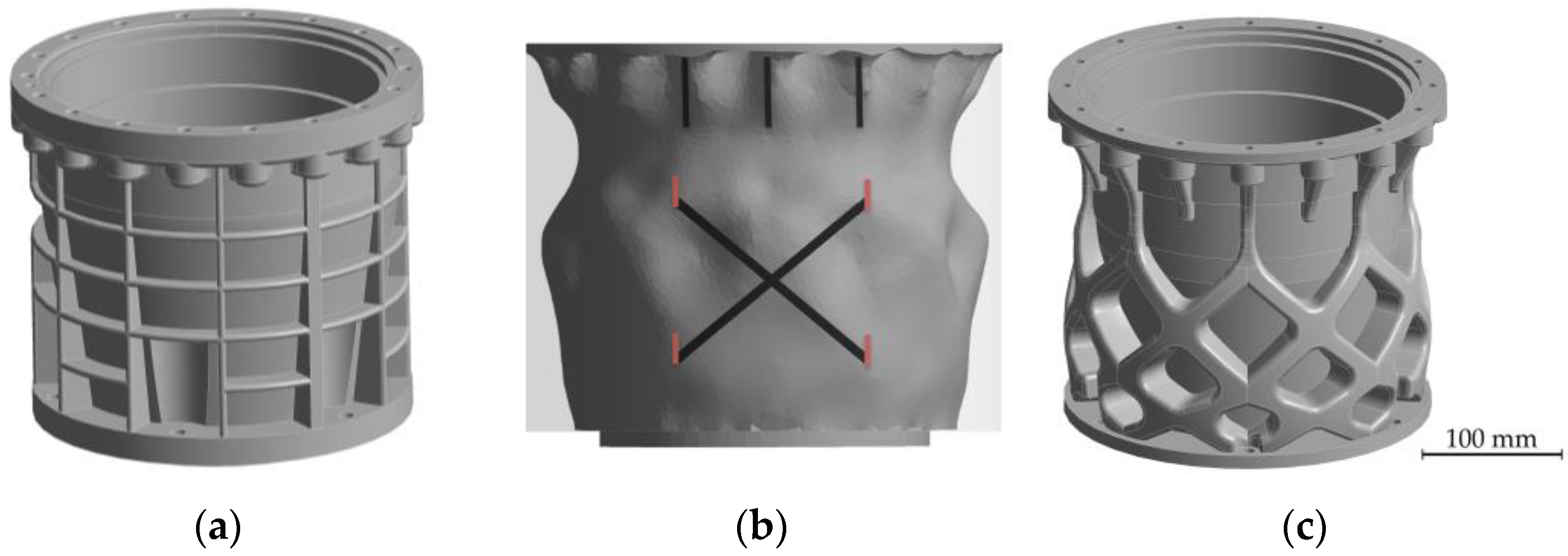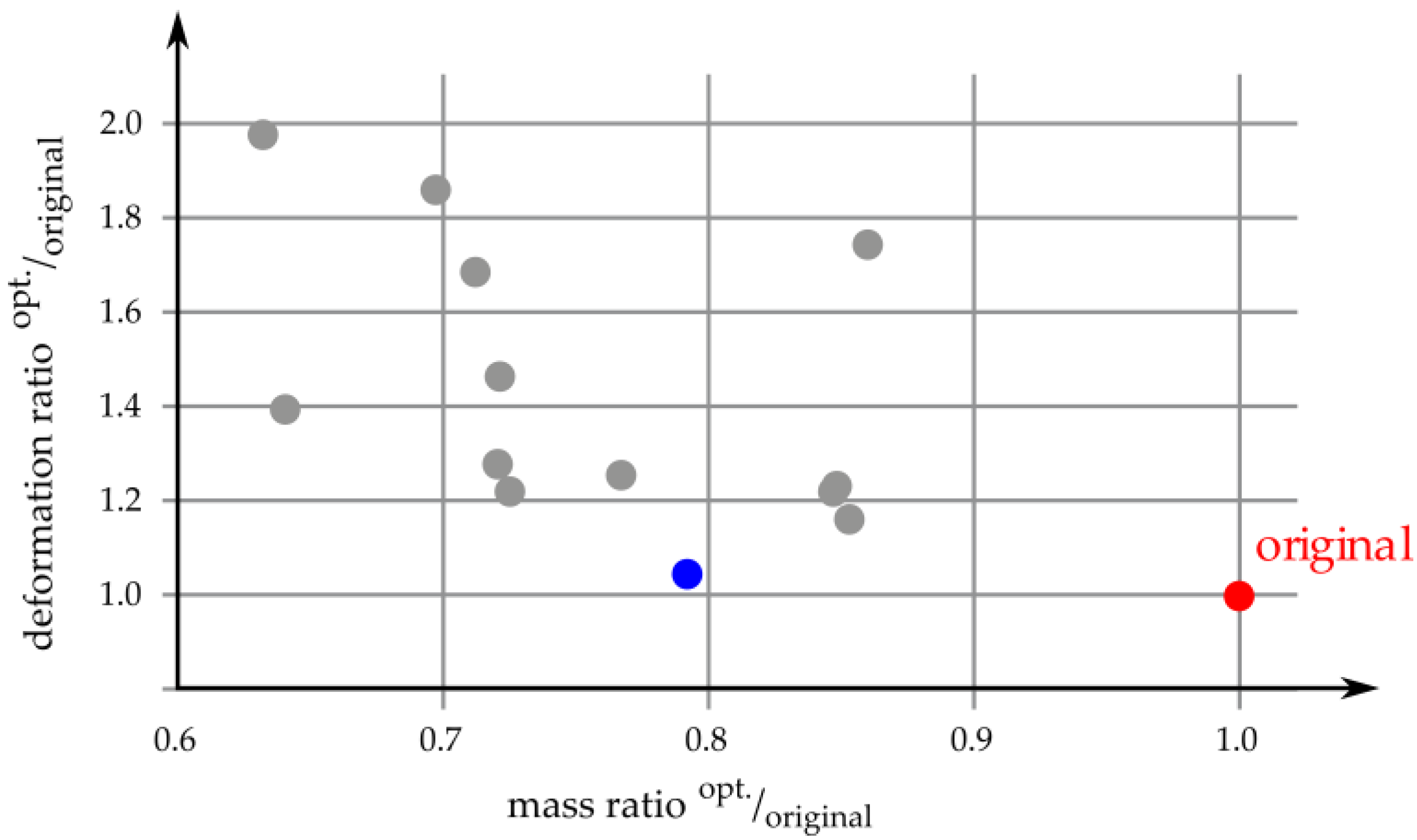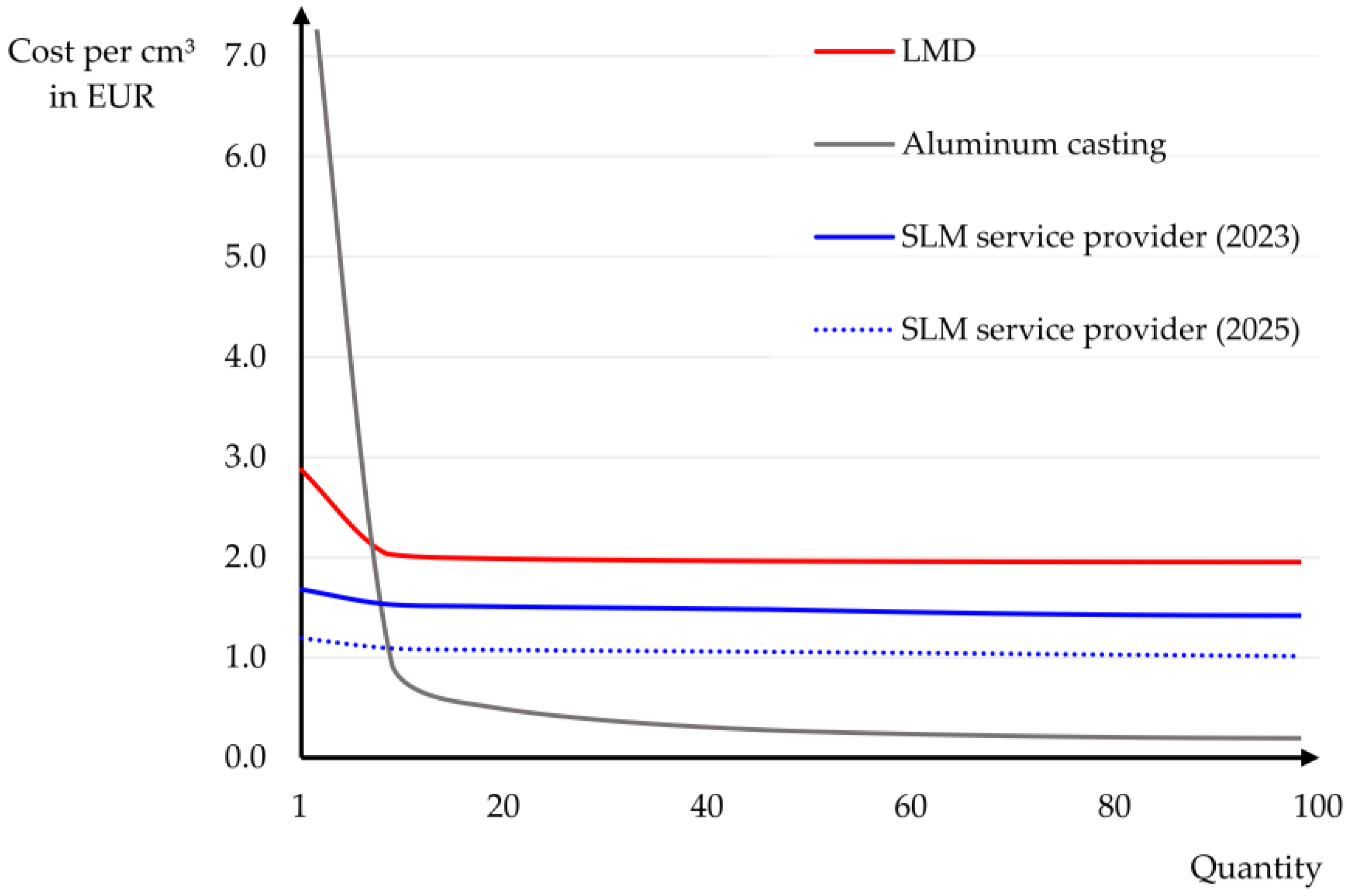Design and Cost Evaluation of Additively Manufactured Electric Vehicle Gearbox Housings †
Abstract
1. Introduction
2. Methods
2.1. Lightweight Design
2.2. Additive Manufacturing Concept
2.3. Material Selection and Simulation
3. Results
3.1. Material Study Results
3.2. Cost Evaluation
4. Conclusions
Author Contributions
Funding
Data Availability Statement
Conflicts of Interest
Abbreviations
| AM | Additive Manufacturing |
| DMLS | Direct Metal Laser Sintering |
| EV | Electric Vehicle |
| HAM | Hybrid Additive Manufacturing |
| HASM | Hybrid Additive–Subtractive Manufacturing |
| LMD | Laser Metal Deposition |
| NVH | Noise, Vibration, and Harshness |
| SLM | Selective Laser Melting |
References
- Jäger, S.; Linde, T. Review of the Cost-Situation of a Lightweight Electric Vehicle Gearbox Housing through Topology Optimization and Additive Manufacturing. In Proceedings of the 38th International Electric Vehicle Symposium and Exhibition (EVS 38) Proceedings, Gothenburg, Sweden, 15–18 June 2025. [Google Scholar]
- Hermann, F.; Vogt, S.; Göbel, M.; Möller, M.; Frey, K. Laser Metal Deposition of AlSi10Mg with high build rates. Procedia CIRP 2022, 111, 210–213. [Google Scholar] [CrossRef]
- Magerramova, L.; Isakov, V.; Shcherbinina, L.; Gukasyan, S.; Petrov, M.; Povalyukhin, D.; Volosevich, D.; Klimova-Korsmik, O. Design, Simulation and Optimization of an Additive Laser-Based Manufacturing Process for Gearbox Housing with Reduced Weight Made from AlSi10Mg Alloy. Metals 2022, 12, 67. [Google Scholar] [CrossRef]
- Ghasempour-Mouziraji, M.; Lagarinhos, J.; Afonso, D.; Alves de Sousa, R. A review study on metal powder materials and processing parameters in Laser Metal Deposition. Opt. Laser Technol. 2024, 170, 110226. [Google Scholar] [CrossRef]
- Barreiro, P.; Armutcu, G.; Pfrimmer, S.; Hermes, J. Quality improvement of an aluminum gearbox housing by implementing additive manufacturing. Forsch. Ingenieurwesen 2022, 86, 605–616. [Google Scholar] [CrossRef]
- Barreiro, P.; Bronner, A.; Hoffmeister, J.; Hermes, J. New improvement opportunities through applying topology optimization combined with 3D printing to the construction of gearbox housings. Forsch. Im Ingenieurwesen 2019, 83, 669–681. [Google Scholar] [CrossRef]
- Cui, D.; Aggarwal, A.; Leparoux, M. Laser metal deposition of titanium on stainless steel with high powder flowrate for high interfacial strength. Int. J. Mater. Form. 2024, 17, 18. [Google Scholar] [CrossRef]
- Zhong, C.; Liu, J.; Zhao, T.; Schopphoven, T.; Fu, J.; Gasser, A.; Schleifenbaum, J.H. Laser Metal Deposition of Ti6Al4V—A Brief Review. Appl. Sci. 2020, 10, 764. [Google Scholar] [CrossRef]
- Bruzzo, F.; Medapati, M.P.R.; Pullini, D.; Ronco, F.; Bertinetti, A.; Tommasi, A.; Riede, M.; Lòpez, E.; Brückner, F. Sustainable laser metal deposition of aluminum alloys for the automotive industry. J. Laser Appl. 2022, 34, 042004. [Google Scholar] [CrossRef]
- Muslim, T.; Karagoz, T.; Kurama, S.; Sezer, P.; Yazici, O.F.; Ozkok, R. Laser metal deposition of 17–4 PH stainless steel: Geometrical, microstructural, and mechanical properties investigation for structural applications. CIRP J. Manuf. Sci. Technol. 2023, 41, 69–79. [Google Scholar] [CrossRef]
- González-Barrio, H.; Calleja-Ochoa, A.; Norberto López de Lacalle, L.; Lamikiz, A. Hybrid manufacturing of complex components: Full methodology including laser metal deposition (LMD) module development, cladding geometry estimation and case study validation. Mech. Syst. Signal Process. 2022, 179, 109337. [Google Scholar] [CrossRef]
- Armstrong, M.; Mehrabi, H.; Naveed, N. An overview of modern metal additive manufacturing technology. J. Manuf. Process. 2022, 84, 1001–1029. [Google Scholar] [CrossRef]
- Liu, J.; Huang, J.; Zheng, Y.; Hou, S.; Xu, S.; Ma, Y.; Huang, C.; Zou, B.; Li, L. Challenges in topology optimization for hybrid additive–subtractive manufacturing: A review. Comput.-Aided Des. 2023, 161, 103531. [Google Scholar] [CrossRef]
- Ibhadode, O.; Zhang, Z.; Sixt, J.; Nsiempba, K.M.; Orakwe, J.; Martinez-Marchese, A.; Ero, O.; Shahabad, S.I.; Bonakdar, A.; Toyserkani, E. Topology optimization for metal additive manufacturing: Current trends, challenges, and future outlook. Virtual Phys. Prototyp. 2023, 18, e2181192. [Google Scholar] [CrossRef]
- Bendsøe, M.P.; Sigmund, O. Topology Optimization: Theory, Methods, and Applications, 2nd ed.; Springer: Berlin/Heidelberg, Germany, 2011; ISBN 364207698X. [Google Scholar]
- Sigmund, O.; Maute, K. Topology optimization approaches. Struct. Multidiscip. Optim. 2013, 48, 1031–1055. [Google Scholar] [CrossRef]
- Qi, L.; Zhou, J.; Jin, P.; Wang, M.; Su, Y.; Zhou, H.; Liu, G.; Song, L. Low noise optimization of two-stage gearbox housing structure based on acoustic contribution analysis and topology optimization. J. Mech. Sci. Technol. 2023, 37, 4533–4544. [Google Scholar] [CrossRef]
- Kim, B.-S.; Han, H.-W.; Chung, W.-J.; Park, Y.-J. Optimization of gearbox housing shape for agricultural UTV using structural-acoustic coupled analysis. Sci. Rep. 2024, 14, 4145. [Google Scholar] [CrossRef] [PubMed]
- Son, G.-H.; Kim, B.-S.; Cho, S.-J.; Park, Y.-J. Optimization of the Housing Shape Design for Radiated Noise Reduction of an Agricultural Electric Vehicle Gearbox. Appl. Sci. 2020, 10, 8414. [Google Scholar] [CrossRef]
- Li, Z.; Wang, L.; Lv, T. Additive manufacturing-oriented concurrent robust topology optimization considering size control. Int. J. Mech. Sci. 2023, 250, 108269. [Google Scholar] [CrossRef]
- Shi, Z.; Liu, B.; Yue, H.; Wu, X.; Wang, S. Noise Reduction of Two-Speed Automatic Transmission for Pure Electric Vehicles. Vehicles 2023, 5, 248–265. [Google Scholar] [CrossRef]
- Gillich, N.; Sîrbu, N.; Vlase, S.; Marin, M. Study of Metallic Housing of the Adder Gearbox to Reduce the Noise and to Improve the Design Solution. Metals 2021, 11, 912. [Google Scholar] [CrossRef]
- Schuhmann, D.; Rockinger, C.; Merkel, M.; Harrison, D.K. A Study on Additive Manufacturing for Electromobility. World Electr. Veh. J. 2022, 13, 154. [Google Scholar] [CrossRef]
- Kokare, S.; Oliveira, J.P.; Santos, T.G.; Godina, R. Environmental and economic assessment of a steel wall fabricated by wire-based directed energy deposition. Addit. Manuf. 2023, 61, 103316. [Google Scholar] [CrossRef]
- Ferreira, B.; Brandão, F.; Borille, A.; Gonçalves, A.; Leite, M.; Ribeiro, I. Assessment of the technical, environmental and economic trade-offs in the early stage of metal additive manufacturing adoption. Prog. Addit. Manuf. 2025, 1–23. [Google Scholar] [CrossRef]
- Khorasani, M.; Ghasemi, A.; Rolfe, B.; Gibson, I. Additive manufacturing a powerful tool for the aerospace industry. Rapid Prototyp. J. 2022, 28, 87–100. [Google Scholar] [CrossRef]
- Mecheter, A.; Tarlochan, F.; Kucukvar, M. A Review of Conventional versus Additive Manufacturing for Metals: Life-Cycle Environmental and Economic Analysis. Sustainability 2023, 15, 12299. [Google Scholar] [CrossRef]
- Khanna, N.; Salvi, H.; Karaş, B.; Fairoz, I.; Shokrani, A. Cost Modelling for Powder Bed Fusion and Directed Energy Deposition Additive Manufacturing. J. Manuf. Mater. Process. 2024, 8, 142. [Google Scholar] [CrossRef]
- Xu, J.; Fei, Y.; Zhu, Y.; Yu, W.; Yao, D.; Zhou, J.G. A Review of Non-Powder-Bed Metal Additive Manufacturing: Techniques and Challenges. Materials 2024, 17, 4717. [Google Scholar] [CrossRef] [PubMed]
- Wu, Y.; Fang, J.; Wu, C.; Li, C.; Sun, G.; Li, Q. Additively manufactured materials and structures: A state-of-the-art review on their mechanical characteristics and energy absorption. Int. J. Mech. Sci. 2023, 246, 108102. [Google Scholar] [CrossRef]
- Jäger, S.; Schätzle, J.; Linde, T. Top-Down Validation Framework for Efficient and Low Noise Electric-Driven Vehicles with Multi-Speed Gearbox. World Electr. Veh. J. 2022, 13, 228. [Google Scholar] [CrossRef]
- Jäger, S.; Linde, T.; Von Schulz, K. Product Development Methodology Targeting Efficiency and Acoustics of E-Mobility Gearboxes. Tus (Tribol. Und Schmier.) 2024, 71, 33–41. [Google Scholar] [CrossRef]
- Kadir, A.Z.A.; Yusof, Y.; Wahab, M.S. Additive manufacturing cost estimation models—A classification review. Int. J. Adv. Manuf. Technol. 2020, 107, 4033–4053. [Google Scholar] [CrossRef]
- Mandolini, M.; Sartini, M.; Favi, C.; Germani, M. Cost Sensitivity Analysis for Laser Powder Bed Fusion. Proc. Des. Soc. 2022, 2, 1411–1420. [Google Scholar] [CrossRef]
- Rahmani, R.; Bashiri, B.; Lopes, S.I.; Hussain, A.; Maurya, H.S.; Vilu, R. Sustainable Additive Manufacturing: An Overview on Life Cycle Impacts and Cost Efficiency of Laser Powder Bed Fusion. J. Manuf. Mater. Process. 2025, 9, 18. [Google Scholar] [CrossRef]
- Ferreira, B.T.; de Campos, A.A.; Casati, R.; Gonçalves, A.; Leite, M.; Ribeiro, I. Technological capabilities and sustainability aspects of metal additive manufacturing. Prog. Addit. Manuf. 2024, 9, 1737–1773. [Google Scholar] [CrossRef]






| Name | Material Designation | Density [g/cm3] | Young’s Modulus [GPa] | Poisson’s Ratio | Specific Modulus [GPa⋅cm3/g] |
|---|---|---|---|---|---|
| Aluminum | AlSi7Mg | 2.68 | 70.0 | 0.35 | 26.1 |
| Titanium | Ti6Al4V | 4.43 | 110.0 | 0.34 | 24.8 |
| Magnesium | MgAl3Zn1 | 1.78 | 44.7 | 0.31 | 25.2 |
| Stainless Steel | X5CrNiMo17-12-2 | 7.95 | 195.0 | 0.25 | 24.5 |
| No. | Version * | Turned Part Material | Stiffening Structure Material | Weight [kg] | Rotational Deformation [μm] | Natural Frequency, First Mode [Hz] |
|---|---|---|---|---|---|---|
| 1 | 2 | Aluminum | Magnesium | 6.40 | 11.70 | 1383 |
| 2 | 1 | Aluminum | Magnesium | 6.44 | 11.33 | 1376 |
| 3 | 2 | Titanium | Magnesium | 8.12 | 9.21 | 1392 |
| 4 | 1 | Aluminum | Aluminum | 8.41 | 9.34 | 1382 |
| 5 | 1 | Titanium | Magnesium | 9.93 | 8.47 | 1334 |
| 6 | 2 | Titanium | Aluminum | 10.04 | 7.48 | 1390 |
| 7 | 1 | Aluminum | Titanium | 10.76 | 7.51 | 1337 |
| 8 | 1 | Titanium | Aluminum | 11.21 | 7.22 | 1359 |
| 9 | 2 | Stainless Steel | Magnesium | 11.59 | 6.47 | 1362 |
| 10 | 2 | Stainless Steel | Aluminum | 13.51 | 5.33 | 1408 |
| 11 | 1 | Stainless Steel | Magnesium | 15.83 | 5.32 | 1294 |
| 12 | 1 | Stainless Steel | Aluminum | 17.11 | 4.76 | 1330 |
Disclaimer/Publisher’s Note: The statements, opinions and data contained in all publications are solely those of the individual author(s) and contributor(s) and not of MDPI and/or the editor(s). MDPI and/or the editor(s) disclaim responsibility for any injury to people or property resulting from any ideas, methods, instructions or products referred to in the content. |
© 2025 by the authors. Published by MDPI on behalf of the World Electric Vehicle Association. Licensee MDPI, Basel, Switzerland. This article is an open access article distributed under the terms and conditions of the Creative Commons Attribution (CC BY) license (https://creativecommons.org/licenses/by/4.0/).
Share and Cite
Jäger, S.; Linde, T. Design and Cost Evaluation of Additively Manufactured Electric Vehicle Gearbox Housings. World Electr. Veh. J. 2025, 16, 552. https://doi.org/10.3390/wevj16100552
Jäger S, Linde T. Design and Cost Evaluation of Additively Manufactured Electric Vehicle Gearbox Housings. World Electric Vehicle Journal. 2025; 16(10):552. https://doi.org/10.3390/wevj16100552
Chicago/Turabian StyleJäger, Steffen, and Tilmann Linde. 2025. "Design and Cost Evaluation of Additively Manufactured Electric Vehicle Gearbox Housings" World Electric Vehicle Journal 16, no. 10: 552. https://doi.org/10.3390/wevj16100552
APA StyleJäger, S., & Linde, T. (2025). Design and Cost Evaluation of Additively Manufactured Electric Vehicle Gearbox Housings. World Electric Vehicle Journal, 16(10), 552. https://doi.org/10.3390/wevj16100552







